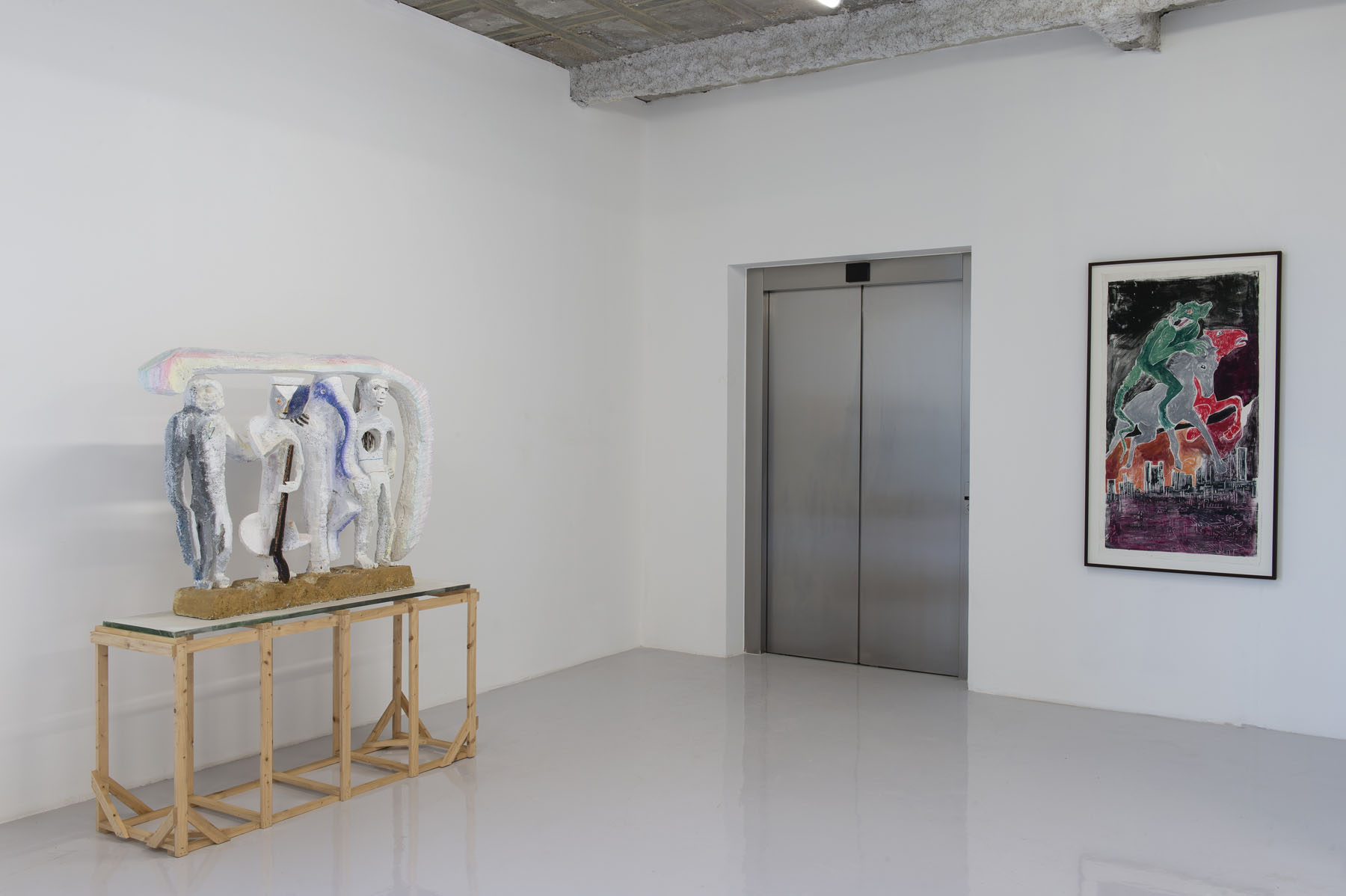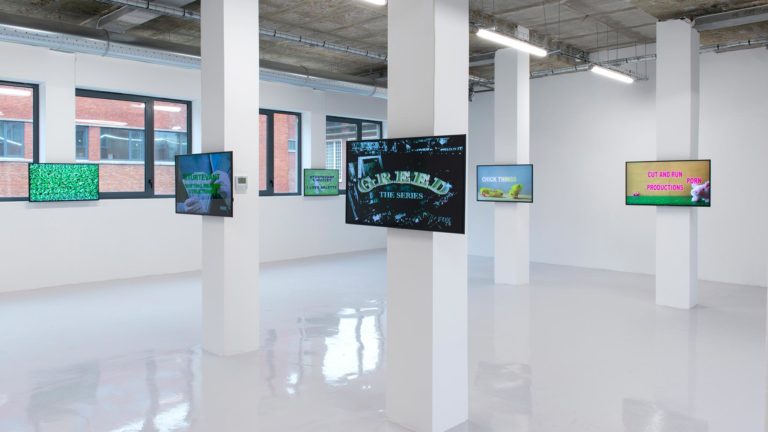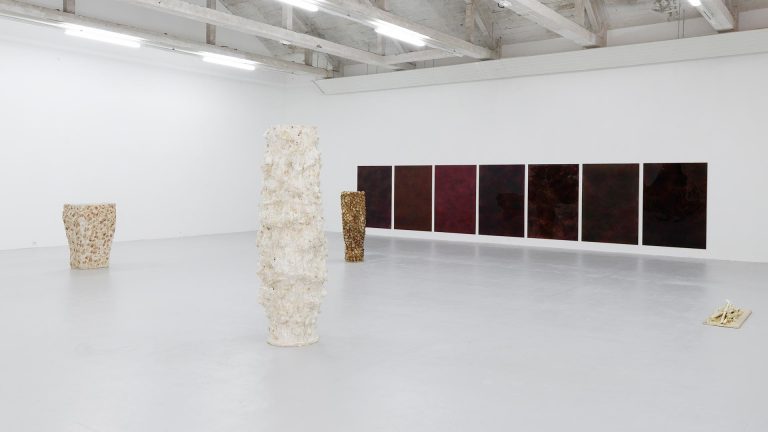Artists: Evgeny Antufiev, Lucy Bull, Horia Damian, Louise Giovanelli, Rodrigo Hernández, Jill Mulleady, Lin May Saeed
Exhibition title: El oro de los tigres
Curated by: Ana Mendoza Aldana
Venue: Air de Paris, Paris, France
Date: January 12 – March 14, 2020
Photography: all images copyright and courtesy of the artists and Air de Paris
The yellow sun pursues its slow course behind the horizon.
The last amber leaves have carpeted the ground, retaining in their belly the echo of a warmish autumn, ahead of the imminent ashen snow.
Other hints of ochre are stirring, in the form of flowers, trees and yellow shrubs with yellow thorns. You could count the thousands of seeds and acid spores till you lose count, till you lose your mind.
When a fire burns out, still further away, the flames revive. The rumbling of the earth lights up the dusk. The sand in the hourglass has formed its pyramid.
In their cage Borges’s golden tigers retrace yet again the path ∞ times taken, obstinately fulfilling their repetitive destiny with frenzied determination.
Maybe their stripes are hiding the divine writing (1) .
Deep in the heart of the threads stretching from grandmother to father, from father to son, the cells multiply their degeneration. The emerald rims of the nebula are already impinging on the retina and the globe is covered with thick fog. Blindness sets in as the pages of the endless library are overlaid with a fine blue dust, and yet the yellow remains, in, scattered constellations.
*
In the dark times
Will there also be singing? Yes, there will also be singing. About the dark times (2).
*
Jorge Luis Borges is famous for the density and brevity of his narratives, peopled with mirrors, labyrinths and his vast love of philology. For him time is a spatio-temporal continuum (3). Between June and August 1977 Borges (1899–1986) gave a series of talks at the Teatro Coliseo in Buenos Aires. La Ceguera (Blindness) was the seventh and last of these talks (4). La Ceguera begins on a personal note: Borges learned very young that he would go blind. In the talk, as in El oro de los tigres (1972)5, the poem written some years earlier, he pays tribute to this blindness, describing it not as a slow descent into darkness (as if someone were little by little putting out the lights), but rather as the gradual loss of colour.
Le Rouge et le Noir, as he says in his talk, are the colours he misses. He is never immersed in total darkness: the world seems to him swathed in a blue and a green that have lost their vividness, and a dirty grey has taken the place of white… Yellow alone has conceded nothing to blindness. Its brightness and sunny radiance remain intact. Thus it becomes a faithful companion, ready to resurface in the writer’s happiest memories: contemplation of wild beasts in the zoo, with the gold of their downy skin teasing his child’s eye.
Long after these talks, over a year ago, yellow suddenly started popping up everywhere for me too: in the demonstrations that shook France in November 2018, and since then in the equivalents that seemed to be rumbling in other parts of the world, like the aftershocks of a single earthquake. In Algeria, Bolivia, Hong Kong, Lebanon, Chile; in feminist writings of more than a century ago (1) ; in the fires consuming chunks of Amazonia, California, Australia; and at the very moment of this writing, in the dead leaves blanketing the footpaths of Paris.
A recurring yellow become embodied, physical hypertext: a revealer of the waves buffeting our reality.
The artists invited to take part in this exhibition have in common a relationship with time going beyond the immediate and the instantaneous. Their work has its roots in the literature and the fables of ancient civilisations, and the archetypal forms they have given rise to. An overlaying of a past and stories converging with our present.
Evgeny Antufiev (1986, Kyzyl, Russia) has an innate practice of art. The Russian artist is particularly interested in eternity and in etiological tales (his work is nourished for example by the legends of the nomads of the Touva region in Siberia where he was born) that he reinterprets in his own manner. Often embellished by semi-precious stones, bones or animal’s teeth that he collects, Antufiev’s sculptures retain the marks of their handmade craft.
Lucy Bull’s (1990, New York) virtuoso paintings call upon the history of painting and abstract art. The works she produces are hallucinated visions that seem to float between dreams and the digital images produced by artificial intelligence. In her paintings, although mainly abstract, we could almost see flowers blossoming, fish swimming, insects swarming, or tigers lurking ready to ambush us — we almost see them move, we almost hear their wings or fins agitating, we almost anticipate the tearing of their claws.
Romanian artist Horia Damian (1922, Bucharest – †2012, Paris) lived and worked most of his life in Paris. His work is mostly interested in simple forms and colors that reflected his interest in cosmic landscapes, stellar architectures and invisible geometries, and the connections between the macro and the microcosmos. The Hill or La Colline is one of his main projects as bear witness the quantity of preparatory sketches drawn. The Hill both a sculpture and a place, a yellow work of obvious spiritual elevation, was installed in front of the Guggenheim in New York in 1976.
Louise Giovanelli’s (1993, London) paintings draw inspiration as much from the cinematographic culture than from Renaissance paintings. From canvas to canvas, the same image might appear with some small variations: sometimes the surface of the painting has been scratched, the color altered, almost as if each painting was a different print of one single photograph or if each canvas was a projection of a movie whose film had been damaged by the passing of time. On a single painting can then coexist the snapshot of Elizabeth Taylor’s tracheotomy scar and a devotional image of a martyr’s beheading.
Rodrigo Hernández’s (1983, Mexico DF) sculptures, volumes and paintings function as a compendium of meaning. A same idea, a word (its definition, the way it is written) or an image, is explored simultaneously from different angles. The simplest forms can thus embody a plethora of of mental associations. Hernández’s pieces can be apprehended as a work-word-image-porte-manteau…
Times are dark in Jill Mulleady’s paintings (1980, Montevideo), where different time periods coexist (their architectures, their characters fashionably dressed, their food, their excesses, their domestic or wild fauna) always in a disturbing manner. In Fight-Or-Flight a giant rat rides a horse over a random city: maybe the Four Horsemen of the Apocalypse have a different face than the one we were expecting.
Lin May Saeed (1973, Würzburg), addresses the human-animal relationship and the animal liberation movement. Her works often crafted in Styrofoam — a material that because of its very slow decay will persist longer than wood, iron, marble, and most noble materials generally used in classical sculpture — borrow their aesthetics and vocabulary from ancient civilizations and thousands of years old mythologies, imagining a future where animals and humans now coexist in peace.
1) In The Writing of the God, a god of a pre-Columbian civilization has hidden a sacred phrase capable of staving off all the wrongs of the end of the world in the spots of a jaguar. Jorge Luis Borges, La escritura del dios, in El Aleph, ed. Emecé, 1949
2) Bertolt Brecht, Motto, in Svendborgdigte, section II, 1939
3) Time is a river which sweeps me along, but I am the river; it is a tiger which destroys me, but I am the tiger; it is a fire which consumes me, but I am the fire. The world, unfortunately, is real; I, unfortunately, am Borges.” Jorge Luis Borges, Obras completas, Emecé, Buenos Aires, 1996. 816 p
4) The conference can be watched in its entirety on Youtube : https://www.youtube.com/watch?v=LLjd2eo62II
5) El oro de los tigres, ed. Emecé, 1972, 168 p
El oro de los tigres, 2020, exhibition view, curated by Ana Mendoza Aldana, Air de Paris
El oro de los tigres, 2020, exhibition view, curated by Ana Mendoza Aldana, Air de Paris
El oro de los tigres, 2020, exhibition view, curated by Ana Mendoza Aldana, Air de Paris
El oro de los tigres, 2020, exhibition view, curated by Ana Mendoza Aldana, Air de Paris
El oro de los tigres, 2020, exhibition view, curated by Ana Mendoza Aldana, Air de Paris
El oro de los tigres, 2020, exhibition view, curated by Ana Mendoza Aldana, Air de Paris
El oro de los tigres, 2020, exhibition view, curated by Ana Mendoza Aldana, Air de Paris
El oro de los tigres, 2020, exhibition view, curated by Ana Mendoza Aldana, Air de Paris
El oro de los tigres, 2020, exhibition view, curated by Ana Mendoza Aldana, Air de Paris
El oro de los tigres, 2020, exhibition view, curated by Ana Mendoza Aldana, Air de Paris
El oro de los tigres, 2020, exhibition view, curated by Ana Mendoza Aldana, Air de Paris
El oro de los tigres, 2020, exhibition view, curated by Ana Mendoza Aldana, Air de Paris
Horia Damian, Galaxy 3-I, 1976, pencil and watercolour on paper, 75,2 x 103,8 cm
Louise Giovanelli, Marker III, 2019, Oil on linen, 47,5 x 36,5 cm
Jill Mulleady, Fight-Or-Flight, 2019, woodcut print, 150 x 82 cm
Lucy Bull, Claps Jaw, 2019, Oil on canvas, 84 x 127 x 3 cm
Lin May Saeed, Dach der Welt / The Liberation of Animals from their Cages X, 2010, styrofoam, acrylic paint, polyester, 100 x 140 x 38 cm, 217 x 155 x 48 cm
Rodrigo Hernández, Evá, 2017, oil color, acrylic, wood, papier-maché, 29 x 19 x 9 cm
Rodrigo Hernández, Working title: J’aime Eva, drawing 3, 2017, paint and collage on paper, cadre, 77 x 50 cm

























